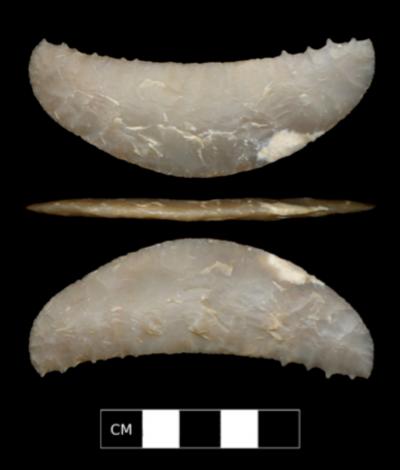We're open daily! View holiday hours
Science News
A Place by the Coast
March 7, 2011
by Anne Holden

California’s Channel Islands, a group of eight islands just off the coast of southern California, house one of the richest and most diverse collections of land and marine animals anywhere in the world. But a new discovery into the island’s ancient past reveals a rich history of human settlement as well.
In a new study published last week in the journal Science, a team of archaeologists, led by the University of Oregon and the Smithsonian Institution, has unearthed a massive collection of stone tools that date back to the islands’ earliest American Indian settlers.
Excavations at three sites on Santa Rosa and San Miguel islands yielded scores of projectile points and oddly shaped tools called “crescents.” In many cases, these tools were so delicate that there’s only one place they could have been used: underwater.
“This is among the earliest evidence of seafaring and maritime adaptations in the Americas,” said Jon Erlandson, executive director of the Museum of Natural and Cultural History at the University of Oregon and one of the paper’s co-authors. “The points we’re finding are extraordinary, the workmanship amazing. It’s a very sophisticated chipped-stone technology.”
These tools date to between 12,200 and 11,400 years ago, several thousand years after the first Americans are believed to have crossed the Bering Strait from Asia in present-day Alaska. When the first people arrived at the Channel Islands, they weren’t islands at all, but one large island surrounded by shallow sea. Sea levels in this region were about 200 feet lower than they are today, and the islands were connected to each other.
What makes these archaeological finds so exciting to researchers is not only their abundance and preservation, but their style. The delicate stemmed and crescent tools are entirely unlike the more well known Clovis point technology found throughout much of North America. The Channel Islands’ discovery lends credence to an increasingly popular idea: the makers of the maritime tools took a more coastal path from Alaska than their Clovis-making counterparts.
Several years ago, Erlandson proposed the idea of a “kelp highway,” from Japan to California, rich in marine life such as seals, seabirds, and fish. Could the Channel Islands settlers be the descendants of these early travelers?
While many questions remain, this and previous discoveries on the Channel Islands have given archaeologists a considerably better understanding about the earliest settlers of coastal California. “[This discovery] shows that very early on, New World coastal peoples were hunting such animals and birds with sophisticated technologies that appear to have been refined for life in coastal and aquatic habitats,” said Torben C. Rick, curator of North American Archaeology at the Smithsonian and one of the paper’s co-authors.
But uncovering how and when these settlers arrived will require more digging. Erlandson and Rick hope to head back to the island in search of earlier sites, retracing these coastal peoples’ steps up the coast of California.
Anne Holden, a docent at the California Academy of Sciences, is a PhD trained genetic anthropologist and science writer living in San Francisco.
Image courtesy of Jon Erlandson